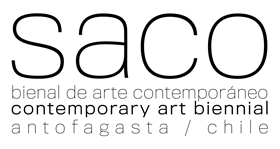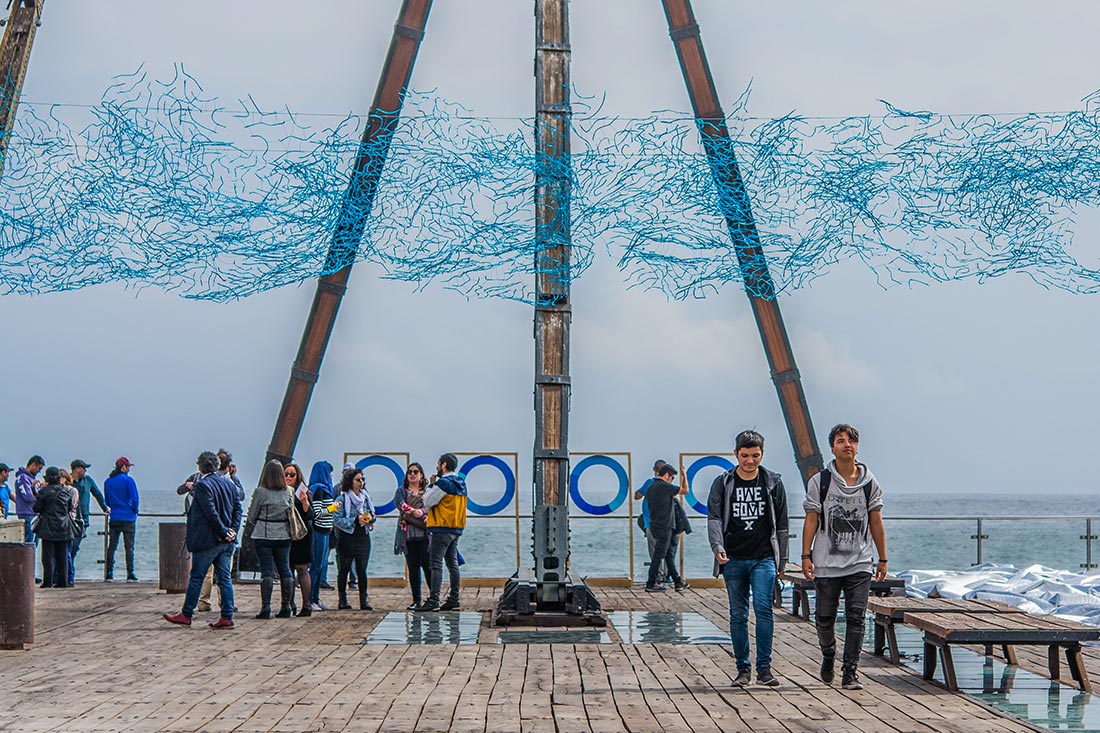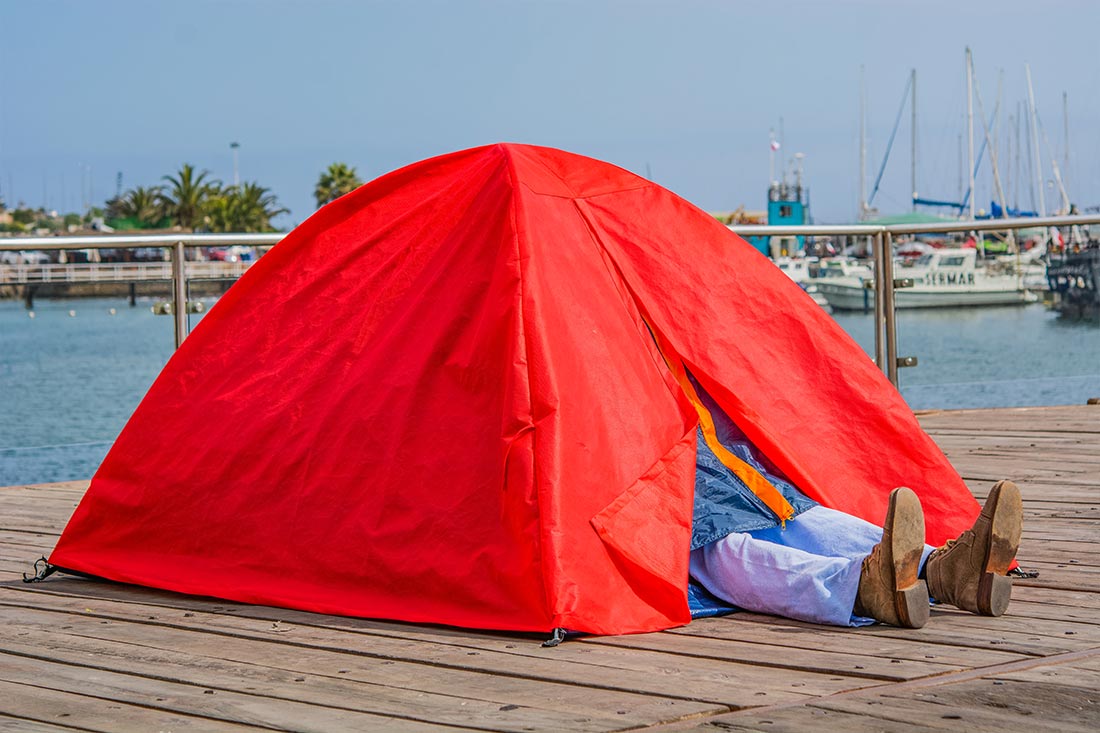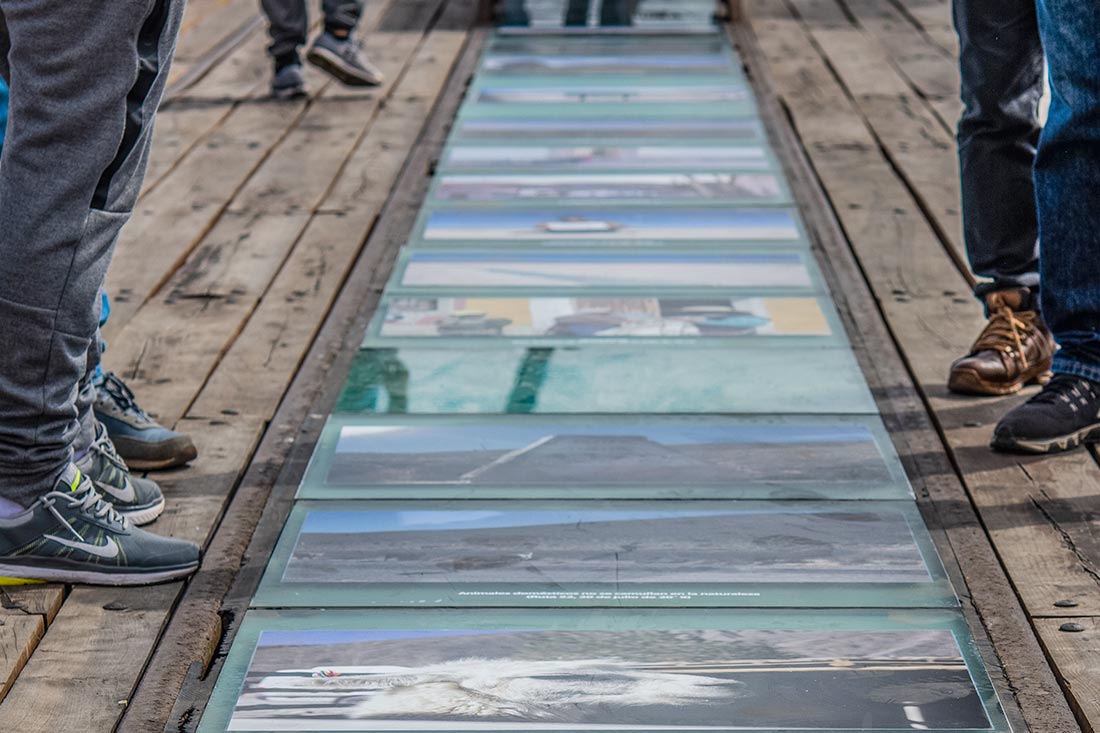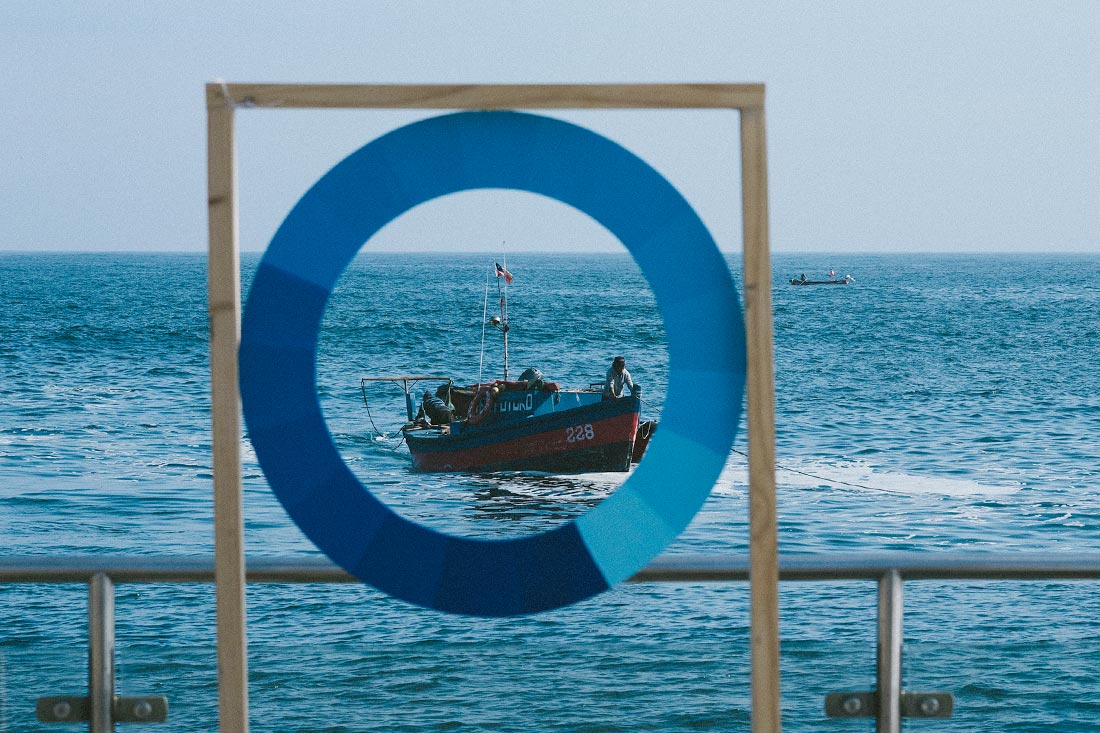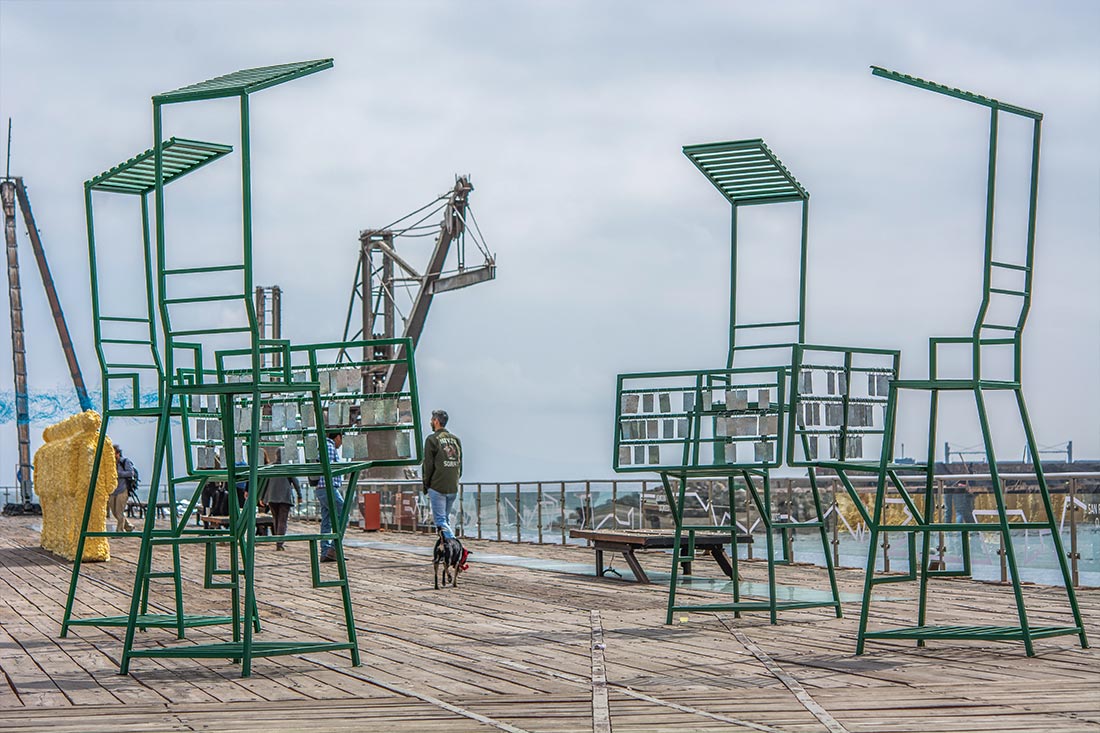International show joins together works of artists from Japan, Poland, Argentina, Brazil, Costa Rica, Venezuela and Mexico.
In exhibition until September 5th are the works of artists selected from among 226 proposals in 32 countries from North and South America, Africa, Europe and Asia, all winners in the international call from the SACO8 Contemporary Art Festival. The solicitation invited artists from all around the world to prepare projects reflecting upon “destiny” as well as the Melbourne Clark pier in Antofagasta, a city situated in the driest place on earth, the Atacama desert.
“Despite the unconformity and the roughness of the winning proposals, their unquestionable beauty brings us hope in the face of destiny. There is no beauty without wisdom, and it is there that we find refuge when faced with the threat of apocalypse. We hope these seven works can illuminate with ideas a variety of piers, paths and walkways”, stressed the festival´s director, Dagmara Wyskiel.
The most awaited exhibition of the festival is composed of seven site specific artworks made exclusively for this pier, a historic and public place which is annually converted into a stage for contemporary art.

Self Monument / Contrail by Yuga Hatta (Japan), a work of sculpture that experiments with the contrail as the base for self-portrait, traces of the human figure, its identity in time and its concern with taking concrete shape in a changing environment.

Endless by Anna Uścińska de Rojas (Poland), installation with the appearance of mining tailings blurring one of the sides of the pier so as to create an environment in which it is possible to be submerged, and that reflects the light, the sky and the water, attempting to capture the essence of the problem, destiny.

The other side of the continent by Patricia Teles (Brazil), logbook of the artist´s journey by land from Rio de Janeiro to her destination: Antofagasta. With translucent vinyl stickers she delivers a “travel story” of 66 hours, from the Atlantic to the Pacific.

Fate (in blue) by Stephanie Williams (Costa Rica), a work inspired by the explorations of the 19th century. An installation made with cyanometers, instruments for measuring the blueness of the sky and the sea, and attempt to reinvent geographies and elucidate the fate of a new route.

Topography of an uncertain future by Guillermo Anselmo Vezzosi (Argentina), a subtle topography floating above the pier, meant to mark the difference between the current sea level and its estimated expansion in the next few thousand years, bringing spectators on a conceptual, apocalyptic journey beneath the sea.

Any Where by Marcos Temoche (Venezuela), a piece that deals with the feeling of uncertainty, alluding to exile and migration. Camping tents with the colors of the Latinoamerican flags arranged in a straight line, inside each tent a dressed mannequin with half of its body outside the tent, facing destiny as if it were a constant trip.

Compound circle by Juan Carlos Guerrerosantos (Mexico), this work is made of referee chairs, facing each other, inviting the spectators to climb up and interact among themselves, while keeping an eye on the prospects and passers-by from above. A circular fiction that allows the contemplation of oneself and the others, observing how numbers change just like we do.
This exhibition is part of the museum without a museum circuit of the Contemporary Art Festival. Begun in 2012 as a self-management initiative in the north of Chile, a region lacking in museums and educational institutionality for the visual arts, the festival activates annually exhibition and educational programmes which foster connection with the territory.
Organized by SE VENDE Collective, presented by Escondida|BHP, funded by the National Fund of Regional Development FNDR 2% Culture, Special Funding Line; in addition to the National Fund for Culture Development and the Arts (Fondart), 2019 call for festivals; and Other Collaborating Institutions Programme, both funds from the Ministry of Culture, Arts and Heritage.
Exposición principal de SACO8:
Obras de arte reflexionan sobre “el destino” en espacio público y patrimonial de la capital minera de Chile
La muestra internacional reúne trabajos de artistas que provienen de Japón, Polonia, Argentina, Brasil, Costa Rica, Venezuela y México.
Hasta el 5 de septiembre estarán en exhibición las obras de los creadores seleccionados de entre 226 propuestas de 32 países de América del Norte y Sur, África Europa y Asia, ganadores de la Convocatoria Internacional de SACO8 Festival de Arte Contemporáneo. Llamado que invitó a artistas de todo el mundo a preparar sus proyectos pensando en el “destino” y en el Muelle Melbourne Clark de Antofagasta, ciudad situada en el lugar más seco del planeta, el Desierto de Atacama.
Su Directora, Dagmara Wyskiel, enfatizó que “a pesar del inconformismo y la dureza de las propuestas ganadoras, es su irrevocable belleza la que nos devuelve la esperanza frente al destino. No hay belleza sin sabiduría, y es allí donde encontramos el refugio frente a la amenaza del apocalipsis. Esperamos que estas siete obras puedan iluminar de ideas viarios muelles, senderos y caminos.”
Son siete trabajos los que se levantan en este espacio patrimonial, que anualmente se convierte en escenario de arte contemporáneo. Obras site specific, hechas exclusivamente para este lugar histórico y público, componen la exhibición más esperada del Festival.

Self Monument / Contrail de Yuga Hatta (Japón), un trabajo escultórico que experimenta con la forma de una estela como soporte de autorretrato , rastros de la figura humana, su identidad en el tiempo y su ansiedad de tomar una forma concreta dentro de un entorno cambiante.

Sinfín de Anna Uścińska de Rojas (Polonia), instalación con apariencia de relave, que diluye uno de los bordes del muelle, para crear un entorno en el cual es posible sumergirse y que refleja la luz, el cielo y el agua, intentando captar la esencia del problema, el destino.

El otro lado del continente de Patricia Teles (Brasil), cartografía de la travesía de la artista por tierra, desde Río de Janeiro hasta su destino: Antofagasta. Por medio de adhesivos vinílicos translúcidos entrega un ”relato de viaje” de 66 horas, desde el Atlántico hacia el Pacífico.

Devenir (en azules) Stephanie Williams (Costa Rica) Trabajo inspirado en las exploraciones del siglo XIX. Instalación con cianómetros, medidores cromáticos para determinar el azul del cielo y el mar, que intentan reinventar geografías y dilucidar el devenir de un nuevo recorrido.

Topografía de un futuro incierto de Guillermo Anselmo Vezzosi (Argentina) una topografía sutil levita sobre el muelle, para marcar la distancia entre el nivel actual del mar y su crecimiento estimado en miles años más, llevando a los espectadores a un viaje conceptual y apocalíptico bajo el océano.

Any Where, Marcos Temoche (Venezuela), una obra que trabaja la sensación de incertidumbre, aludiendo al exilio y a la migración. Tiendas de acampar con los colores de las banderas latinoamericanas colocadas en línea recta, dentro de cada carpa hay un maniquí vestido y con medio cuerpo fuera, asumiendo el destino como un viaje constante.

Círculo Compuesto, Juan Carlos Guerrerosantos (México), este trabajo se compone por sillas de arbitraje, enfrentadas, invitando a subirse e interactuar entre sí y a mirar el horizonte y a los transeúntes desde arriba. Una simulación circular que les permitirá observarse a sí mismos y al otro, viendo cómo los números cambian al igual que nosotros.
Exposición enmarcada dentro del circuito expositivo “museo sin museo” del Festival de Arte Contemporáneo, que nace como una iniciativa autogestionada el 2012 en el norte chileno, una zona carente de museos y con institucionalidad educativa inexistente para las artes de la visualidad y que activa programas anuales expositivos, formativos y de vinculación con el territorio.
Organiza Colectivo SE VENDE, presenta Escondida|BHP, financia el Fondo Nacional del Desarrollo Regional FNDR 2% de Cultura, Línea Especial de Financiamiento, además del Fondo Nacional de Desarrollo Cultural y las Artes (Fondart), línea Festivales, convocatoria 2019; y el Programa Otras Instituciones Colaboradoras, ambos fondos del Ministerio de las Culturas, las Artes y el Patrimonio.
